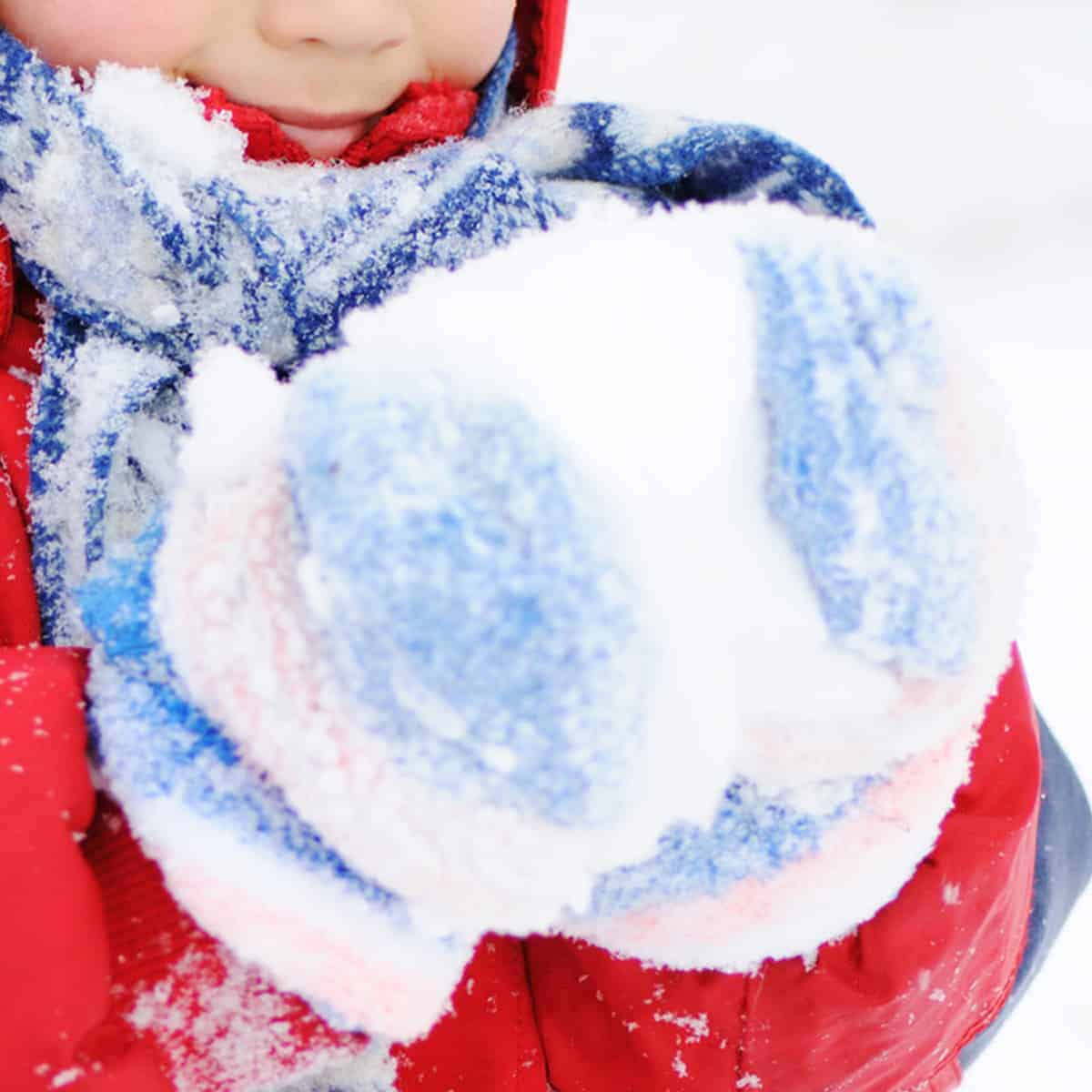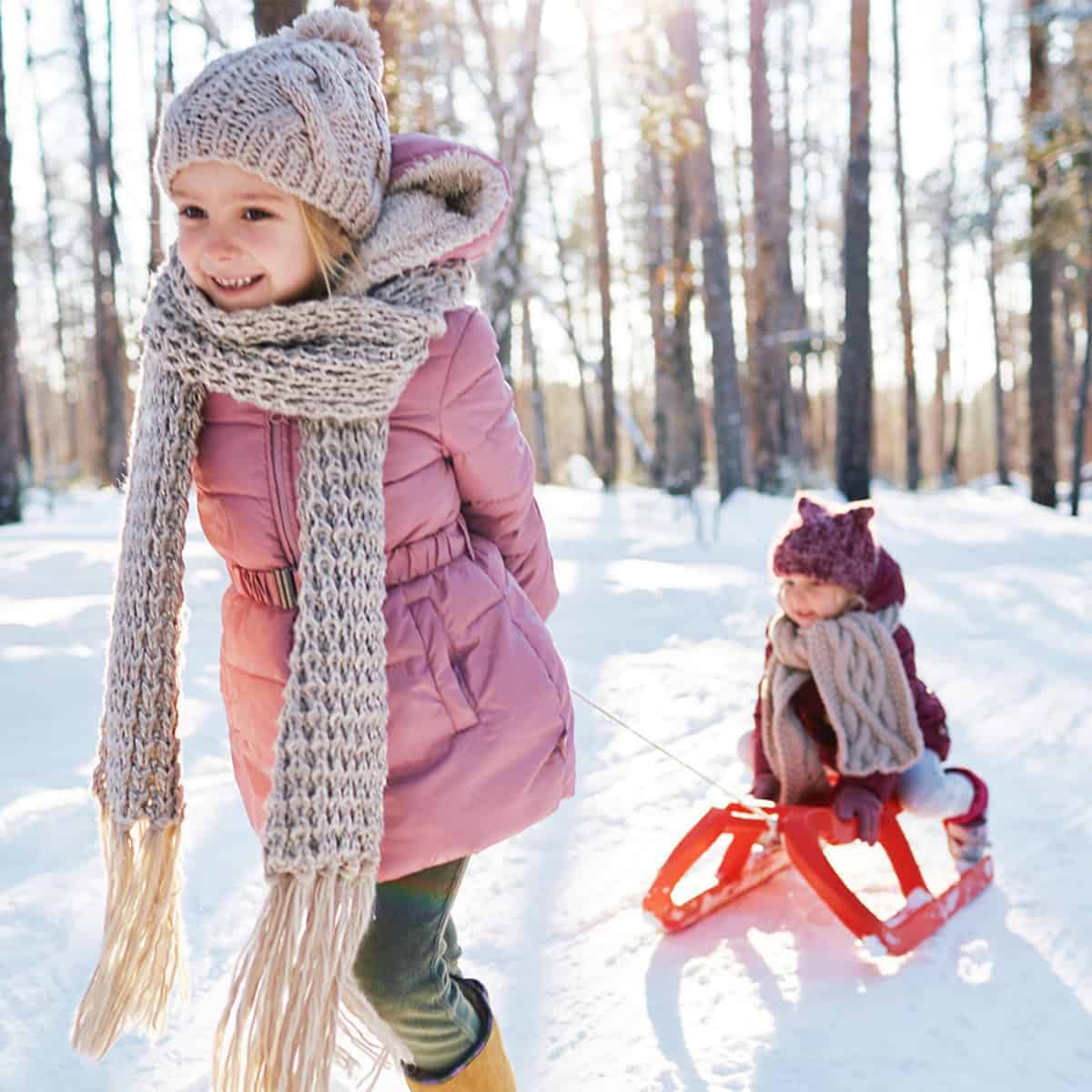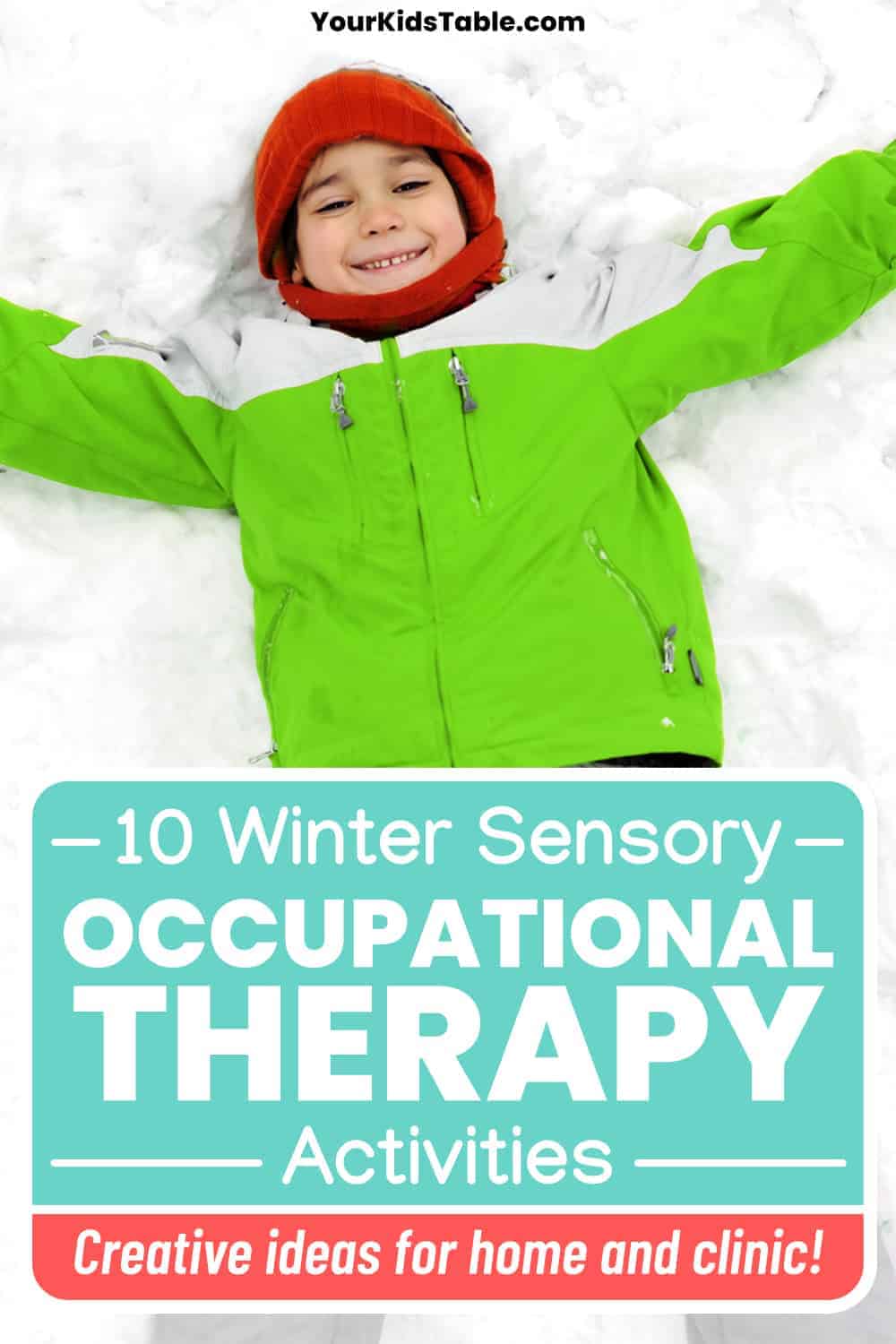Here are 10 sensory activities for you to include in your treatment sessions and share with parents during the winter months. Learn why sensory activities and “heavy work” are important for all kids, and how to include the proprioceptive system during play.
Affiliate links used below. See our full disclosure.
Where I live, the winter months bring cold temperatures, snow, and short days. Warm summer days spent outdoors are a distant memory, and I find myself getting cabin fever when January rolls around.
After the holiday season, my creative ideas for sensory play are at an all time low.
As an occupational therapist, I hear the same from the families I work with. I’m frequently asked what kind of activities I suggest for kids to get energy out, self regulate, and build motor skills when cooped up indoors.
Therapists know how effective movement can be in regulating a child. But even seasoned therapists can run short on ideas when the weather is cold and gloomy.
If you’re a parent looking for some calming sensory activities or an OT looking for some fun treatment ideas, you’re in luck. We have 10 ideas for sensory activities for you to use all winter long.
Which Kids Benefit from Using Sensory OT Activities?
In the clinical setting, I have seen kids for a number of reasons over the years from sensory or behavioral, to motor or coordination difficulties. And what I’ve found is that almost all children benefit from sensory-focused activities.
Sensory activities help kids because developmentally, they are hard-wired to explore the world through their senses.
While it may seem like children with obvious sensory processing difficulties are the only ones who benefit the most from sensory activities, there are many reasons for using them in treatment and play.
Sensory play helps with focus and attention, self-regulation, social emotional skills-building, body awareness, and achieving a variety of developmental skills.
How Sensory Motor Integrations Helps Fine Motor and Gross Motor Skills
Even kids with fine motor or gross motor goals can benefit from sensory-focused intervention, like the winter OT activities you’ll find below.
In fact, sensory processing and the development of motor skills go hand in hand.
In the therapy world, we call this Sensory Motor Integration. Basically, this means that there is a link between nerves (sensory system) and muscles (motor skills).
When you interact with your environment, your sensory system receives a message from the world, interprets it, and your body then reacts or responds through movement. This whole process is called motor planning.
Imagine trying to build a complicated piece of furniture. I’m looking at you, Ikea.
If, for some reason, you can’t read or understand the directions, you probably won’t build it correctly.
Signs of Difficulty with Sensory Processing
Kids who have trouble “reading” information from their environment through their sensory system are more likely to have difficulty responding to their environment appropriately.
If so, you may see any of the following signs:
- Sensory avoidance, like extreme fear of heights, overreaction to touch or texture, easily becoming dizzy, or picky eating.
- Sensory seeking, like fidgeting or hyperactivity, using too much force during play and learning activities, grinding teeth, or purposely bumping into things.
- Motor planning and coordination issues like clumsiness, poor posture, or muscle weakness in hands and body.
- Self regulation struggles like increased meltdowns over transitions, change in routine, or poor coping skills.
- General attention or learning difficulties in school.
Does any of this sound familiar?
If you’re interested in learning more about the sensory system, check out 10 sensory red flags you might be missing.
The examples listed above cover many of the reasons a kid might receive occupational therapy. They’re very common issues that’s why knowing how to support them is important for OT’s.
Remember addressing these sensory issues helps improve focus and attention, increase emotional regulation, and enhances development and well-being. Who doesn’t want that?

Heavy Work: The Important Sensory Technique for Calming and Regulation
You may have heard of the sensory system or the term “sensory diet.”
But have you heard of “heavy work?”
Heavy work is a commonly recommended sensory strategy by occupational therapists. It includes any activity that activates the proprioceptive system and provides resistance to your body.
When you push a stroller or shopping cart, you create resistance.
When you pull a door open, or a jug of milk out of the fridge, you create resistance.
When you carry a heavy laundry basket or bag, you guessed it resistance.
Even activities that create resistance through pressure or gravity, like swimming, are considered heavy work.
Many children engage in heavy work activities without even realizing it. Movements like running, jumping, spinning, climbing, and lifting heavy things help kids make sense of the world around them.
In fact, behaviors deemed as “rough housing” by adults are actually critical to the development of motor skills and self regulation.
If you’re intrigued by this idea and want to know more, get more heavy work activities here.
10 Winter Sensory Occupational Therapy Activities
Now that you understand who benefits from sensory activities, and why, let’s get into what they are!
These activities can be used at home or in a clinical setting as an OT or other type of therapist. We’ve broken them down into a mix of indoor/outdoor play activities and functional everyday tasks that do not require much prep or equipment.
Many of the winter occupational therapy ideas are movement based, but you’ll also find 2 fun winter sensory bin ideas!
Activity #1: Be a Snowplow
Fill a laundry basket or box (aka the pretend snowplow) with books or blankets. Have your child push it across the floor. Try creating a “route” for the snowplow to drive to add vision and body awareness into the activity.
For example, give directions to your child like “plow the snow 4 times back and forth” or “plow a circle around the kitchen table!”
As an alternative, have your child use paper plates under their hands in downward dog pose to pretend to move snow across the room.
Activity #2: Ice Skate
Mimic ice skating and ski movements inside on the floor. Practice squatting down and gliding side to side across the floor. Add in jumps, spins, and create a path for the skier or skater to follow.
*Outdoor skiing and ice skating are also GREAT heavy work activities in and of themselves.
Activity #3: Make a snow angel
Lay on the floor and spread arms and legs out into an angel pattern. Try alternating fast and slow movements while making the angels.
You can add in another sensory layer by having your child do this on different surfaces. How does a plush rug compare to a wood floor, or even outside in the snow?
Activity #4: Snowball fight
Throw pillows, soft plush animals, or even these adorable indoor snowballs. Practice hiding behind objects and dodging snowballs. This is another one that easily translates outdoors to the real thing.

Activity #5: Build a snowman
Roll real snow into balls and stack onto each other. Practice sequencing and spatial skills by decorating and dressing your snowman up.
Do you live somewhere with no snow? Using playdough to make a tabletop snowman still offers the same heavy work benefits! Or, try this fun instant fake sensory snow. The kids at my clinic love this stuff.
Activity #6: Bake cookies
Measure out ingredients and mix dough, roll out and shape using both hands, and decorate. Including your child in cooking and baking tasks helps to work their bodies and minds and add in some sensory exposure.
Check out some of our favorite kitchen tools to use with kids!
Activity #7: Pull and push peers/siblings in a sled
This is a great activity for those with snowy climates. But even indoors, try a laundry basket, cardboard box, or even a large blanket and have one child pull another around.

Activity #8: Shovel or sweep the snow off driveway and sidewalk
You may notice a theme here, that many day-to-day activities and chores qualify as heavy work.
And it’s true, these activities offer a lot of sensory input! Shoveling snow is a wonderful proprioceptive exercise. Sweeping and mopping indoors offers similar benefits. And as a bonus, your kids can help clean the house!
Activity #9: Candy Cane Snow and Sand Sensory Bin:
This one is taste safe and stimulating to the touch and scent systems. It even gets you bonus points for recycling, as it is a great use for all the candy canes you may have left over from Christmas.
All you need is a bin, cheerios or other cereal of choice, candy canes or peppermints, and small toys or figurines. You can get creative and use winter-themed animals, but any toys will do.
In a blender or food processor, blend your cereal until it has a fine “sand” texture. I have used as little as a cup and as much as an entire box. Set aside.
In a zip-lock bag, throw in your candy canes or mints, and crush into desired texture. A hammer or rolling pin wrapped in a kitchen towel does the trick. You could also use a food processor. Your goal is a texture that is grittier than the cereal. This is your “snow.”
Pour cereal into the box and place in animals. Have your child sprinkle the snow however they like over the toys and box. They can have fun mixing it all, or keeping separate.
Activity #10: Frozen Ice Rescue Sensory Bin
No need to live in a cold climate with this sensory bin. You just need a bit of planning ahead.
You’ll need a shoe-box sized bin, water, food coloring (I use blue and 1 other color), utensils such as spoon, fork, small butter knife, and small manipulative toys.
At least a day ahead of time, fill your sensory bin with about ½”-2” of water and add a drop of 2 of blue food coloring. Place 3-5 small toys in the water. They do not need to be fully submerged.
Let freeze overnight. When ready to play, pull the bin out of the freezer and fill to desired level with warm water, adding another 1-2 drops of food coloring in desired color.
Add additional figurines or toys as desired, and let your child play as the ice melts, and colors mix. Your child can chip away at the ice with various utensils to pull the frozen figures out and “rescue” them from the ice.
How to Use Winter Occupational Therapy Activities in Treatment
As with any other treatment strategy, how you use an activity is as important as the activity itself.
It’s going to depend on the child you’re working with and their specific goals and preferences, and it may take a bit of detective work to determine how best these activities should be incorporated in your treatment sessions.
As a general rule- fast, unpredictable, rotary, and explosive movements are alerting. The activities above like skating, snowball fight, and the candy cane sensory bin could all be alerting to your child.
In contrast, slow, linear, predictable, and rhythmic movements are typically calming. Building a snowman, making cookies, or pushing the sled could all calm your child down.
However, sensory integration is an individualized thing, and one size does not fit all in this case.
So, when in doubt, try it out! And see what kind of effect it has on your child.
Also play around with the timing of the activity. Try these at the start of your session to build focus and regulation for seated work. Try them mid-way through as a sensory break, or even use them as a transition from a preferred activity to a non-preferred one.
By experimenting with how a child responds in a treatment session to these activities, you can better share with the parent how to carry over these strategies at home.

How to Use Winter OT Activities as a Parent at Home
If you’re a parent of a child who has been given a sensory diet by an occupational therapist, or you are searching for ways to incorporate heavy work and sensory activities at home, this list is for you as well.
All of the activities above can easily be completed at home as part of your child’s daily routine.
You know your child best, so take a look at their day-to-day struggles.
Is getting out the door in the morning a trigger for a meltdown? Try a couple of these movement activities before leaving the house and see if it helps that transition.
Does sitting down to do homework seem difficult? Even a few minutes of movement and heavy work can do wonders for a child’s focus for seated tasks.
It is my hope that these activities help you add in a little sensory fun into the otherwise sometimes dreary days of winter.
Which activities do you and your child like best? Comment with your favorite one below, and grab our list of 25 Sensory Activities that you can print out and save on your phone!
More Occupational Therapy Activities for Kids
Cool Summer Sensory Ideas for Kids
5 Indoor activities Perfect For Winter
Laura Mau is a licensed occupational therapist and member of the Your Kid’s Table team. She has over 8 years of clinical experience in helping families navigate complex feeding and eating, sensory processing, and reaching developmental milestones with their children. She currently practices in Colorado and has 2 young kids of her own.
Alisha Grogan is a licensed occupational therapist and founder of Your Kid’s Table. She has over 18 years experience with expertise in sensory processing and feeding development in babies, toddlers, and children. Alisha also has 3 boys of her own at home. Learn more about her here.

Thank you for posting! This helped me to think of lots of new activities to do with my child this winter!
Thank you, Maria! So glad you enjoyed 🙂
Best,
Kalyn